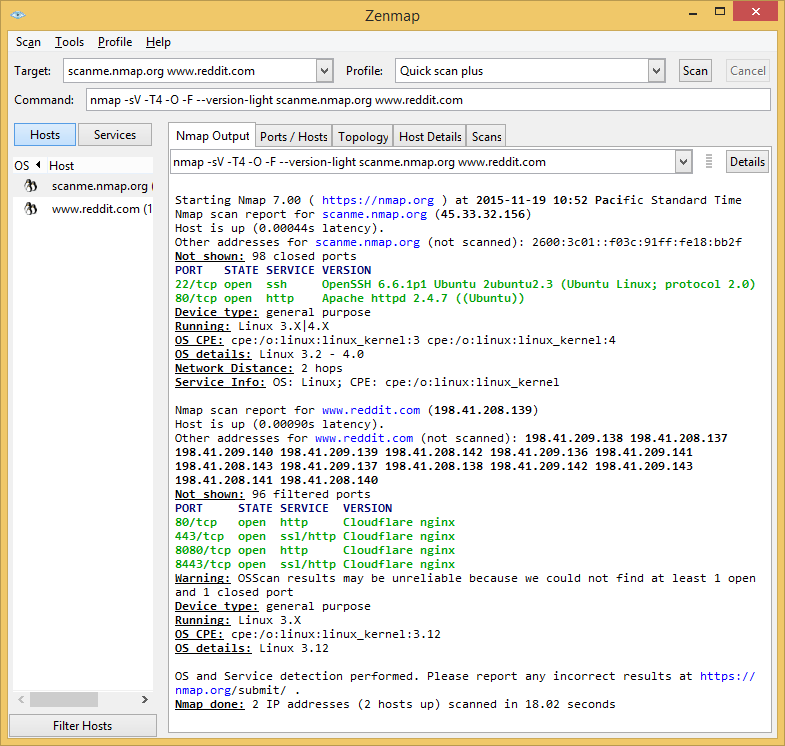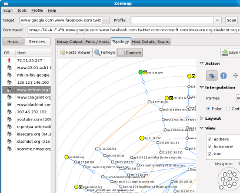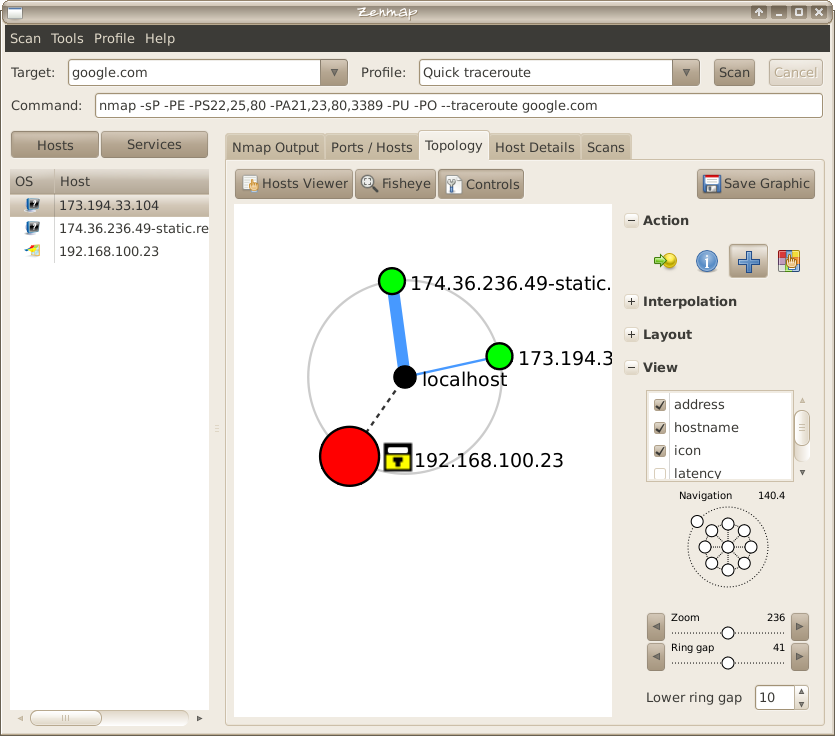

The -sS option is telling Nmap that it should also scan TCP ports using SYN packets. Same as the regular Intense scan, just that we will also scan UDP ports (-sU).

Run a new scan and every new host and network path will be added to the topology automatically. The graph rearranges itself in a smooth animation to reflect the new view of the network.

Click on a host and it becomes the new center. Click and drag to pan the display, and use the controls provided to zoom in and out. Hosts are shown as nodes on a graph that extends radially from the center. Zenmap’s “Topology” tab provides an interactive, animated visualization of the connections between hosts on a network. This comes from having a pretty fast timing template (-T4) and for using the -A option which will try determine services, versions and OS. With the verbose output (-v) it will also give us a lot of feedback as Nmap makes progress in the scan open ports SSh-hostkey & open ports It will make an effort in determining the OS type and what services and their versions are running. Should be reasonable quick, scan the most common TCP ports. We will use the zenmap for legal test we will test on this is the zenmap test website The other way is you can simply run on terminal In linux hosts there are 2 ways of doing it, in case of kali linux and parrot os you can find the icon and click to start and later give it root privileges by entering your password. Zenmap is quite intuitive, but you can learn more about using it from the Zenmap User’s Guide or check out the Zenmap man page for some quick reference information.
#Zenmap topology download#
You can download Zenmap (often packaged with Nmap itself) from the Nmap download page. The results of recent scans are stored in a searchable database. Saved scan results can be compared with one another to see how they differ. Scan results can be saved and viewed later. A command creator allows interactive creation of Nmap command lines. Frequently used scans can be saved as profiles to make them easy to run repeatedly.
#Zenmap topology mac os#
It is a multi-platform (Linux, Windows, Mac OS X, BSD, etc.) free and open source application which aims to make Nmap easy for beginners to use while providing advanced features for experienced Nmap users. Here it is.Zenmap is the official Nmap Security Scanner GUI. Start button is right at the bottom of the screen, right there. Delete it, and start, and click the Start button. In the Options, we are told to clear the Capture Filter.

It gathers packets arriving at a port, or exiting. WireShark is a packet gathering analysis tool. In WireShark, we are told to go to Capture, and Options. We double-click on WireShark, we have WireShark main screen up and running. That is done by minimizing TigerVNC and, there's WireShark. In the domain controller, the 192.168.0.1 desktop, double-click on WireShark. Open the Zenmap, which we have already done. Rightmost pane, the Help text, Kali Linux, Information Gathering, Live Host Identification, and finally at the bottom we should have Zenmap. Another way is if we go to Menu, and that is what we're told in the Help. One way, we can get a shell prompt terminal, and type "zenmap" all lowercase at the shell prompt, and then this will run Zenmap. in order to access Zenmap, we have a couple ways. We give the password, now we are at the desktop of the Kali Linux.
#Zenmap topology password#
The password is password, with a zero in the O-R-D, rather than O-R-D, with the password. TigerVNC we utilized in the first segment. In order to gain access to the Kali server, we need to open TigerVNC. We are right now at the domain controller. The first step we're told to do is go into Applications, Kali Linux, Information Gathering, Live Host Identification, and find Zenmap. In fact, it uses the Nmap command to display network topology, and discoveries which it learns through scanning, and they target network element. This is the second part, using Zenmap, which is a graphical user equivalent of Nmap. I'd like to welcome you to the second part of the network footprinting, the first exercise in network vulnerabilities, module one.


 0 kommentar(er)
0 kommentar(er)
